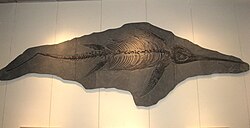
Ichthyosauria is an order of large extinct marine reptiles sometimes referred to as "ichthyosaurs", although the term is also used for wider clades in which the order resides.
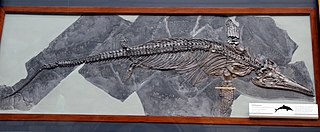
Ichthyosaurus is a genus of ichthyosaurs from the Early Jurassic, with possible Late Triassic record, from Europe. It is among the best known ichthyosaur genera, as it is the type genus of the order Ichthyosauria.

Temnodontosaurus is an extinct genus of ichthyosaur from the Early Jurassic period. They lived between 200 and 175 million years ago (Hettangian-Toarcian) in what is now Western Europe and possibly Chile. It lived in the deeper areas of the open ocean. University of Bristol paleontologist Jeremy Martin described the genus Temnodontosaurus as "one of the most ecologically disparate genera of ichthyosaurs," although the number of valid Temnodontosaurus species has varied over the years.

Stenopterygius is an extinct genus of thunnosaur ichthyosaur known from Europe.

Aegirosaurus is an extinct genus of platypterygiine ophthalmosaurid ichthyosaurs known from the late Jurassic and early Cretaceous of Europe. It was originally named as a species of Ichthyosaurus.
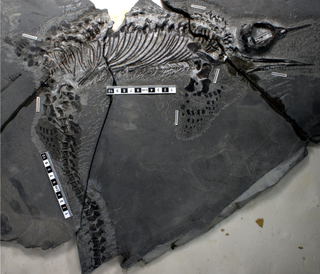
Chaohusaurus is an extinct genus of basal ichthyopterygian, depending on definition possibly ichthyosaur, from the Early Triassic of Chaohu and Yuanan, China.
Californosaurus is an extinct genus of ichthyosaur, an extinct marine reptile, from the Lower Hosselkus Limestone of California, and also the Muschelkalk of Germany.

Excalibosaurus is a monotypic genus of marine prehistoric reptiles (ichthyosaurs) that lived during the Sinemurian stage of the Early Jurassic period in what is now England. It is characterized by the extreme elongation of the rostrum, with the lower jaw about three-quarters the length of the upper jaw, giving the animal a swordfish-like look. The only known species is Excalibosaurus costini.
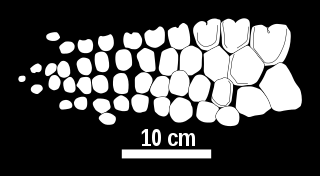
Chacaicosaurus is a genus of neoichthyosaurian ichthyosaur known from the Middle Jurassic of Argentina. The single known specimen of this genus was excavated from the Los Molles Formation in Neuquén Province, and is housed at the Museo Olsacher under the specimen number MOZ 5803. This specimen consists of a skull, forelimb, some vertebrae, and some additional postcranial elements. The genus was named by Marta Fernández in 1994, and contains a single species, Chacaicosaurus cayi, making it the first named distinctive ichthyosaur from the Bajocian stage. It is a medium-sized ichthyosaur with a very long snout, which bears a ridge running along each side. The forelimbs of Chacaicosaurus are small and contain four main digits.

Protoichthyosaurus is a genus of ichthyosaur from the early Jurassic of southern England. Two species are known, P. prostaxalis—the type species, named by Appleby in 1979—and P. applebyi. A third species, P. prosostealis, was named by Appleby, but it was removed from the genus in 2017 due to its similarity to Ichthyosaurus. The genus Protoichthyosaurus was synonymized with Ichthyosaurus by Maisch and Hungerbuhler in 1997, and again by Maisch and Matzke in 2000. However, it was found to be distinct in 2017 by Dean Lomax and colleagues, who separated it from Ichthyosaurus on account of differences in the arrangement and shape of the carpal ossifications, as well as the absence of the fifth digit. The species most likely lived during the Hettangian stage, but may have lived as early as the Rhaetian and as late as the Sinemurian.

Besanosaurus is a genus of Middle Triassic ichthyosaur from Monte San Giorgio of Italy and Switzerland, containing the single species B. leptorhynchus. Besanosaurus was named by Cristiano Dal Sasso and Giovanni Pinna in 1996, based on the nearly complete flattened skeleton BES SC 999, the holotype specimen. This skeleton is preserved across multiple thin rock slabs spanning 3.5 by 4 metres when assembled and took thousands of hours to prepare. Additional specimens from Monte San Giorgio that have previously been considered separate genera, including a partial skull named Mikadocephalus and a well-preserved, largely complete skeleton, have been reinterpreted as additional specimens of Besanosaurus.
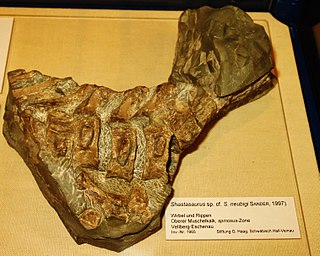
Phantomosaurus is an extinct genus of ichthyosaur that lived during the late Anisian stage of the Middle Triassic. Fossils have been found in southern Germany. It was discovered in 1965 and named in 1997 as a species of Shastasaurus by Sander in the rocks of the Upper Muschelkalk.
Suevoleviathan is an extinct genus of primitive ichthyosaur found in the Early Jurassic (Toarcian) of Holzmaden, Germany.
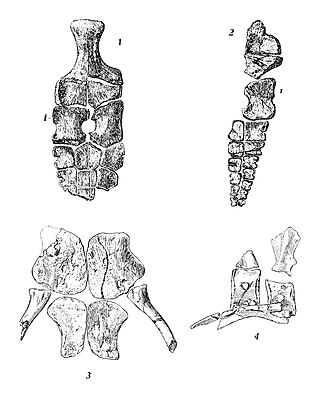
Toretocnemus is an extinct genus of ichthyosaur. Its remains have been found in California, United States, in Triassic layers of the Carnian Hosselkus Limestone.

Arthropterygius is a widespread genus of ophthalmosaurid ichthyosaur which existed in Canada, Norway, Russia, and Argentina from the late Jurassic period and possibly to the earliest Cretaceous.
Mixosauridae was an early group of ichthyosaurs, living between 247.2 and 235 million years ago, during the Triassic period. Fossils of mixosaurs have been found all over the world: China, Timor, Indonesia, Italy, Germany, Spitsbergen, Switzerland, Svalbard, Canada, Alaska, and Nevada.
Hauffiopteryx is an extinct genus of ichthyosaur known from Germany, Luxembourg and Somerset of the United Kingdom. Two species are known: H. typicus and H. altera.

Acamptonectes is a genus of ophthalmosaurid ichthyosaurs, a type of dolphin-like marine reptiles, that lived during the Early Cretaceous around 130 million years ago. The first specimen, a partial adult skeleton, was discovered in Speeton, England, in 1958, but was not formally described until 2012 by Valentin Fischer and colleagues. They also recognised a partial subadult skeleton belonging to the genus from Cremlingen, Germany, and specimens from other localities in England. The genus contains the single species Acamptonectes densus; the generic name means "rigid swimmer" and the specific name means "compact" or "tightly packed".

This timeline of ichthyosaur research is a chronological listing of events in the history of paleontology focused on the ichthyosauromorphs, a group of secondarily aquatic marine reptiles whose later members superficially resembled dolphins, sharks, or swordfish. Scientists have documented ichthyosaur fossils at least as far back as the late 17th century. At that time, a scholar named Edward Lhuyd published a book on British fossils that misattributed some ichthyosaur vertebrae to actual fishes; their true nature was not recognized until the 19th century. In 1811, a boy named Joseph Anning discovered the first ichthyosaur fossils that would come to be scientifically recognized as such. His sister Mary would later find the rest of its skeleton and would go on to become a respected fossil collector and paleontologist in her own right.
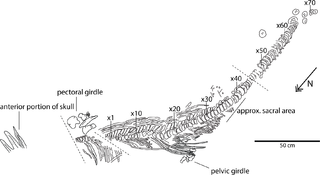
Keilhauia is a genus of ophthalmosaurid ichthyosaur, a type of dolphin-like, large-eyed marine reptile, from the Early Cretaceous shallow marine Slottsmøya Member of the Agardhfjellet Formation in Svalbard, Norway. The genus contains a single species, K. nui, known from a single specimen discovered in 2010 and described by Delsett et al. in 2017. In life, Keilhauia probably measured approximately 4 metres (13 ft) in length; it can be distinguished by other ophthalmosaurids by the wide top end of its ilium and the relatively short ischiopubis compared to the femur. Although it was placed in a basal position within the Ophthalmosauridae by phylogenetic analysis, this placement is probably incorrect.
